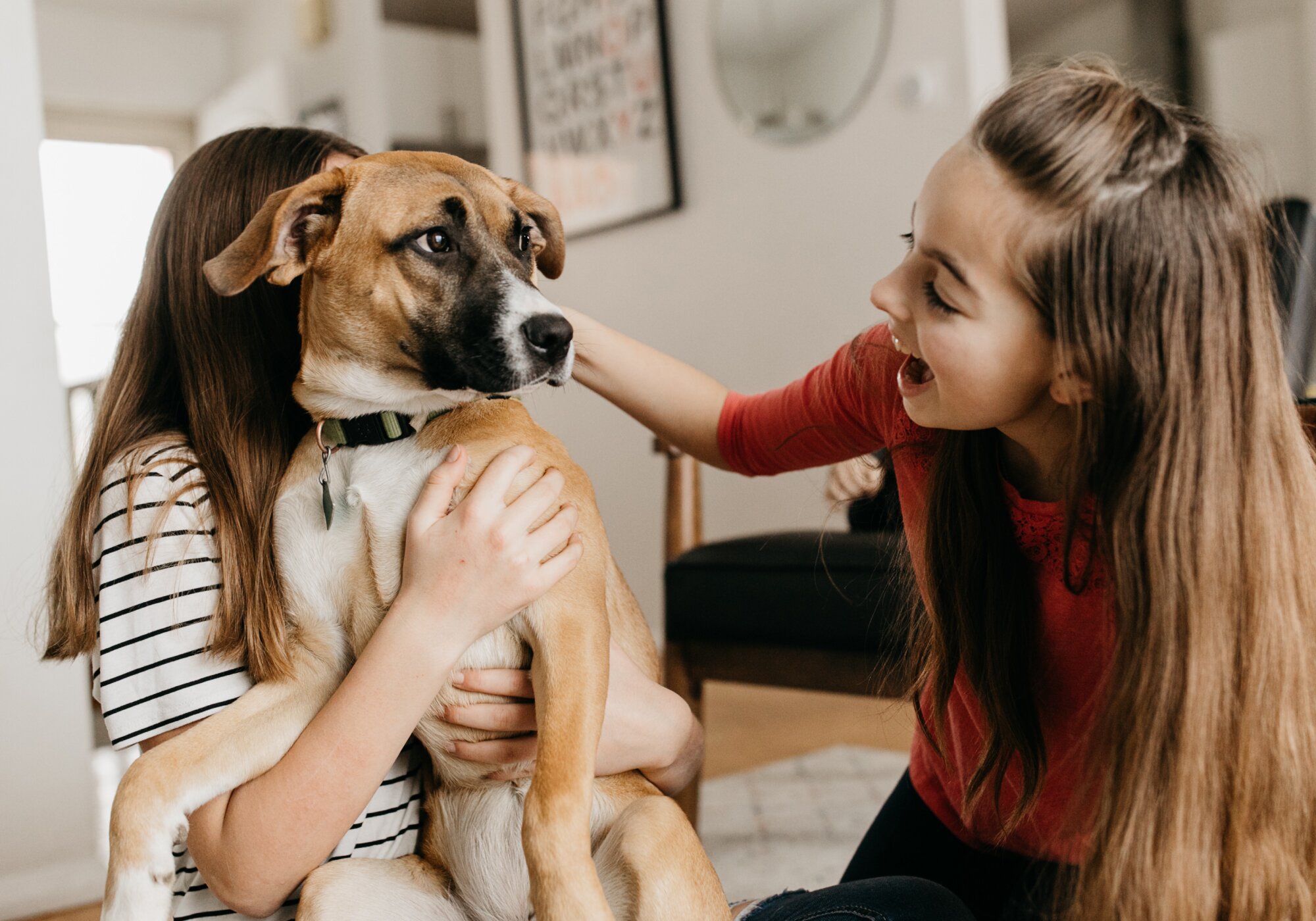Being a pet parent is the greatest, but not every pet experience is enjoyable. If your pet has a run-in with fleas or ticks, you may feel a little uncomfortable in your own home. Especially because fleas can jump from dogs to humans, and vice versa.
This isn't great news for you or your furry friend. But it is possible to get rid of fleas on your pet entirely. And learning everything you can about fleas can help you prevent them in the first place.
In this article, you'll learn:
- What are fleas
- What do they look like
- What is the flea life cycle
- Types of fleas
- Where, when, and how dogs get fleas
- What to do if your dog has fleas

What are fleas
Fleas are wingless insects that live in all regions of the world. Adult fleas are very tiny and may reach only 1/64 of an inch in size. They feed exclusively on the blood of mammals and birds.
Fleas are the most common of all the annoying pests your dog will encounter. They're known for causing skin irritation and infection and transmitting disease to animals and humans. They are one of the most common causes of skin disease in dogs and cats.
Fleas and ticks go hand-in-hand because of their shared love of warm, damp climates. Ticks also transmit diseases including Lyme disease and Rocky Mountain spotted fever.
What do fleas look like on dogs

If you've ever found a black speck on your pet you might've Googled, "What do fleas look like?" They can be a little hard to decipher, especially on dark-coated pets.
When you're unsure, there are several telltale signs and health risks:
1. Adult fleas.
Fleas are visible to the naked eye, though they are very difficult to spot. They are about the size of a pinhead, dark brown, and almost flat-looking.
2. Flea dirt.
Flea infestations can create a lot of flea dirt (aka flea feces). Flea dirt looks like round, black specks, almost like black pepper. A flea comb is helpful to have on hand to help you find flea dirt and a wet paper towel can help you get rid of flea dirt. Because flea dirt is digested blood, it may look like red spots.
3. Flea bites.
Flea bites can cause redness, swelling, and itching. Flea bites can cause skin irritation and discomfort for pets. Flea bites can also cause anemia in pets, especially puppies and kittens.
4. Irritated skin.
Flea infestations can cause skin disease, allergic reactions, and discomfort for pets. If your dog has an allergic reaction to the saliva in a flea bite you may see red bumps or welts on your dog’s skin and even hair loss. This is called flea allergy dermatitis, a common skin condition from flea bites.
5. Anemia.
While a less common symptom, fleas can cause anemia in pets. This usually shows up in small dog and cat breeds, puppies, and kittens. But this typically only happens if your pet is dealing with an infestation and they are left untreated. They may appear lethargic or sluggish and have pale gums.
What is the flea life cycle on dogs

The stages of flea development take a few weeks. But, you'll probably start noticing your dog scratching before then.
The four life stages of fleas are:
- Eggs
- Larvae
- Pupae
- Adults
The flea life stages begin when female adult fleas deposit or lay eggs after feeding. Even though you may only find one or two on your dog at first, in a few days an adult female flea can lay hundreds of eggs.

Flea eggs
After feeding, females lay eggs in your pet's coat. Flea eggs are pearly white and oval-shaped. As your dog moves around, eggs will drop and land in bedding, carpet, and outdoor environments where they will start to hatch. This stage can last up to six days.
It's difficult to see flea eggs on dogs. This is why it's important to:
- Bathe your pet in soapy, hot water, or flea shampoo
- Use a flea comb to look for them
- Apply monthly flea and tick prevention
- Vacuum carpets in your house regularly
- Treat with flea and tick control products in your home

Flea larvae
To hatch into larvae, flea eggs need to settle in shaded, damp areas. Some examples in and around your home include dog houses, decks, porches, and cracks in damp flooring. Sandy environments are great for the larval stage which can last five to 18 days.

Flea pupae
At the end of the larval stage, larvae develop silk-like cocoons and become pupae. Flea pupae are egg-shaped and tend to nest deep in the soil, carpets, furniture, and animal bedding. The pupal stage lasts about two weeks until the adult flea is ready to emerge.
In a dark, moist environment, if the pupa or pre-emerged adult flea doesn’t hatch from their cocoons, they can remain in your home year-round.

Adult flea
Adult fleas emerge from their cocoon and start searching for a host. When the female flea finds one, it bites your pet's skin to feed on your dog and take a blood meal. Fleas live off of your pet's blood (and sometimes human blood).
Live fleas run all over the dog’s body and in your pet's fur — unlike ticks that stay in a specific place. Quickly after feeding the flea egg production starts and lasts for 14 days. This is when you'll likely notice flea dirt (dangerous because it means your pet has been bitten).
If fleas aren't removed via grooming, flea products, or insecticides, female fleas begin feeding right away. In some cases, they can stick around for several months. Consult your veterinarian if your pet's flea infestation is out of control.

Types of fleas on dogs
There are over 2,000 species of fleas, and roughly 300 of those live in the United States. While the most common domestic flea is the cat flea, other kinds include dog, human, and rat.
All fleas look similar, so it can be hard to tell the difference between species. Here are some characteristics of the most common types of fleas on dogs.
Cat fleas
Cat fleas are by far the most common of all fleas. Unprotected animals can bring fleas indoors and infect indoor cats. They can also carry dangerous diseases and cause skin irritation and allergic reactions. Some include murine typhus and cat-scratch disease.
Dog fleas
Dog fleas aren’t exclusive to dogs. They also like to find hosts in wild animals like raccoons, opossums, and livestock. Like cat fleas, the dog flea carries a tapeworm parasite called Dipylidium caninum.
Ground squirrel flea
This flea is common in ground squirrels, California squirrels, rock squirrels, chipmunks, and rats. The ground squirrel flea transmits plague bacteria to humans and animals alike.
Oriental rat fleas
Less common than cat and dog fleas, if no other animals are available to oriental rat fleas they may find a home in your pet. These types are carriers of the bubonic plague and murine typhus.
Tropical hen (sticktight) flea
Usually found on domestic fowls like chickens, “sticktight” fleas will make their way to nearby dogs and cats. While less common than cat or dog fleas, if you live on or near a farm you may run into this type of flea.
Human flea
There are two variations of this type of flea — human and false human fleas. Because they are closely related, they are often found in the same locations.
Where, when, and how dogs get fleas
Finding a flea, or a few, on your dog is stressful. It can make you ask lots of questions like:
- Can dogs get fleas in the winter?
- Where do dogs get fleas?
- Do I only need to kill adult fleas?
Fleas can survive in even the harshest of conditions. Here’s what you need to know about where dogs get fleas, when to look for them, and how they end up on your pet.
Where do dogs get fleas

Fleas like to live around the head, neck, and groin area of dogs and cats. But, they can settle in all over your pet. They can be tricky to locate as they crawl quickly and tend to stay under the fur.
The most common places to search for fleas include:
- Ears
- Eyes
- Neck
- Stomach
- Armpits
- Legs
- Tail
How to check for fleas
Fleas tend to reside in these few key areas. To check for fleas use a flea comb and part your dog's hair at the neck, base of the tail, and belly. Check for flea droppings, which look like specks of dirt. Remove fleas then soak the comb in a bowl of soap and warm water.
When do dogs get fleas
Most fleas can’t survive the cold, but they’ll do anything to stay alive. They will nest on pets without protective treatments or nest in crawl spaces or attics. As long as they remain protected from the cold, fleas may survive all year long.
How do dogs get fleas

There are a lot of ways for healthy dogs to pick up fleas. Dogs and puppies get fleas from their environment or by being close to another animal.
Fleas can jump onto your dog:
- From other animals (deer, rabbits, squirrels, mice) or pets
- From your clothes (fleas can bite humans but do not live on them)
- In the backyard as your pet rolls around and plays
- In a place with unprotected pets (like kennels or dog parks)
Once a flea has latched onto your dog, it's very easy for your pup to become a breeding ground for many fleas.
What to do if your dog has a flea infestation
A flea can go from one to many in minutes. But remember, it’s not your fault your dog has fleas — they are not a sign of a dirty home.
If parasites are nearby, they will seek out your pets. And if your pets are unprotected or spend a lot of time outdoors with animals that carry fleas, parasites will take full advantage.
To keep your pet in good health and treat fleas for good, follow these simple steps.
1. Learn the signs and symptoms of flea bites.
If you spot fleas on your pets, you might already be dealing with a flea infestation. Fleas and ticks cause severe illnesses like FAD and Lyme disease. Know these signs and symptoms and contact a doctor of veterinary medicine right away:
- Flea dirt
- Tiny bugs
- Hair loss
- Pale gums
2. Prevent fleas with topical medications.
There are many solutions for pet parents to kill fleas — from Dawn dish soap and flea medications to topical treatments. Look for a treatment that:
- Kills adult fleas, flea larvae, and flea eggs
- Prevents fleas (and as a result flea bites)
No matter what you choose, flea treatments work best when used regularly. Make sure your pet stays on a consistent flea treatment plan to kill and prevent fleas.
VET TIP
Other types of flea medications include flea shampoo (medicated shampoo), oral medication, flea collars, and injected flea treatment. Consider flea treatment products that are regulated by the Environmental Protection Agency (EPA).
3. Keep your home flea-free.
Killing fleas on your dog is only the first step. Immature flea stages may make your home an infested environment by lurking in your baseboards and floors.
Here are some steps to keep your home flea-free:
- Vacuum carpets regularly and mop hardwood floors with detergent.
- Wash bedding often and keep yards free of debris.
- Use household flea sprays that kill fleas, ticks, and more and help control infestations.
If you're dealing with a flea problem, don't stress. At PetFriendly, we have a flea product for every scenario. From full-blown flea infestation to one flea on your dog's back, we'll help you get rid of your flea problem.


